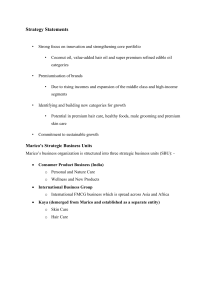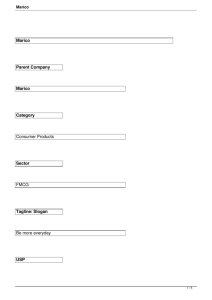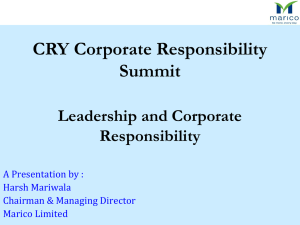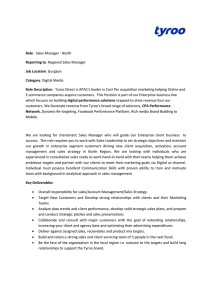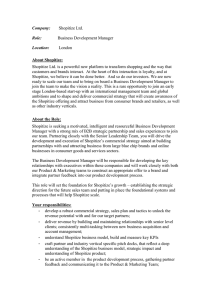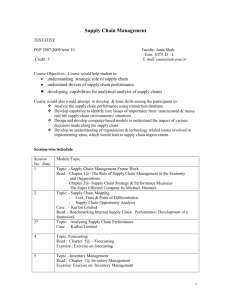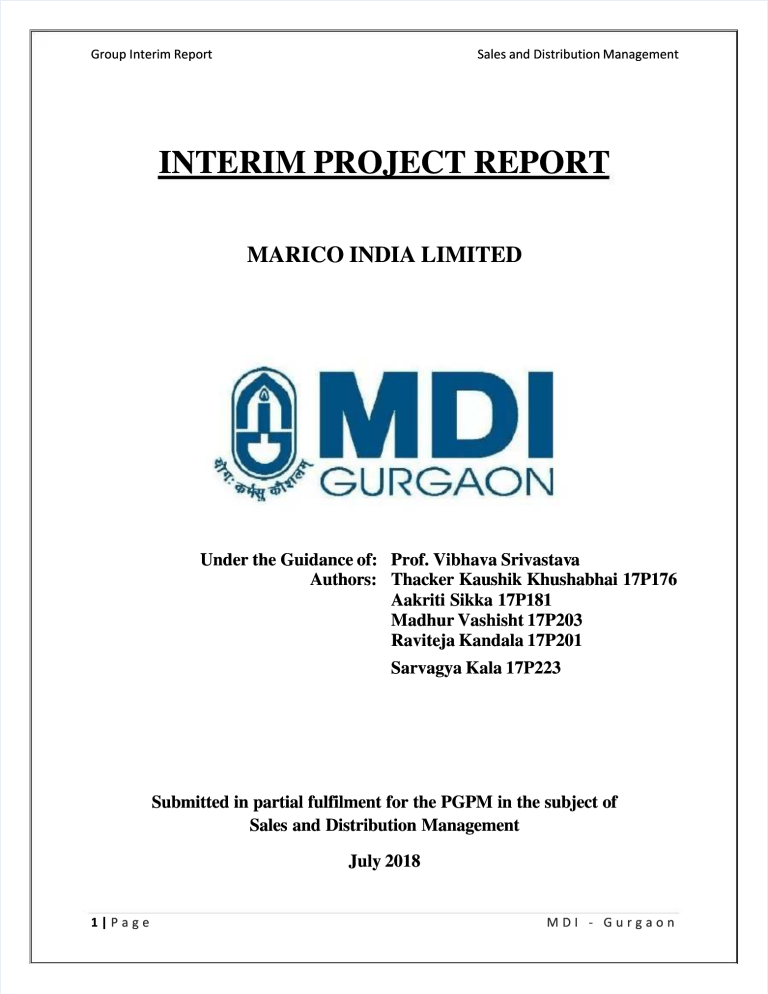
Group Interim Report Sales and Distribution Management INTERIM PROJECT REPORT MARICO INDIA LIMITED Under the Guidance of: Prof. Vibhava Srivastav Srivastava a Authors: Thacker Kaushik Khushabhai 17P176 Aakriti Sikka 17P181 Madhur Vashisht 17P203 Raviteja Kandala 17P201 Sarvagya Kala 17P223 Submitted in partial fulfilment for the PGPM in the subject of Sales and Distribution Management July 2018 1|Page MDI - Gurgaon Group Interim Report Sales and Distribution Management Table of Contents 1. Objective ................................... .................. ................................... ................................... ................................... ................................... ................................... ................................... .................... ... 3 2. Industry - Company Overview.................................. ................. ................................... ................................... ................................... ................................... ....................... ...... 4 2.1 FMCG Goods ................................. ................ .................................. ................................... ................................... ................................... .................................... ............................. ........... 4 2.2 Rural – Set to Rise ............................................................................................................................ 4 2.3 Urban Trends ................................. ................ .................................. ................................... ................................... ................................... .................................... ............................. ........... 4 2.4 Top Companies ................................. ................ .................................. ................................... ................................... ................................... .................................... .......................... ........ 5 2.5 Expectations of Millennials .................................. ................. ................................... ................................... ................................... ................................... ....................... ...... 5 2.6 Marico ................................... .................. ................................... ................................... ................................... ................................... ................................... ................................... .................... ... 6 3. Distribution .................................. ................. ................................... ................................... .................................. ................................... .................................... ................................... ................. 8 3.1 Network - Channels ................................... ................. ................................... .................................. ................................... ................................... ................................... .................. 8 3.2 Key Characteristics ................................. ................ .................................. ................................... ................................... .................................. ................................... ..................... ... 8 4. Customer Analysis ................................... .................. .................................. ................................... ................................... ................................... .................................... ..................... ... 10 4.1 Product Mix – Primary Target ........................................................................................................ 10 4.2 Category wise Market Share ................................. ................ ................................... ................................... ................................... ................................... ..................... .... 10 4.3 Market Share Growth – FY17 ......................................................................................................... 10 4.4 Buying Products - Propositions................................... .................. .................................. ................................... .................................... ................................. ............... 11 4.5 Urban – Rural Market Share ........................................................................................................... 11 5. Competitors .................................. ................. ................................... ................................... .................................. ................................... .................................... ................................. ............... 12 5.1 Marico ................................... .................. ................................... ................................... ................................... ................................... ................................... ................................... ................... 12 5.2 ITC .................................. ................. ................................... ................................... ................................... ................................... ................................... ................................... ........................ ....... 12 5.3 Dabur..................................... Dabur.................... ................................... ................................... ................................... ................................... ................................... ................................... ................... 13 5.4 Godrej ................................... .................. ................................... ................................... ................................... ................................... ................................... ................................... ................... 14 5.5 HUL ................................... .................. ................................... ................................... ................................... ................................... ................................... ................................... ..................... .... 15 5.6 Colgate Palmolive ................................... .................. .................................. ................................... ................................... ................................... .................................... .................. 15 5.7 Proctor & Gamble ................................... .................. .................................. ................................... ................................... ................................... .................................... .................. 16 6. Problem Statement and Symptoms ................................. ................ .................................. ................................... .................................... ................................. ............... 18 6.1 Problem Introduction ................................... .................. ................................... ................................... ................................... ................................... .............................. ............. 18 6.2 Problem Statement .................................. ................. .................................. ................................... ................................... .................................. ................................... .................... 18 6.3 Problem Identified .................................. ................. .................................. ................................... ................................... .................................. ................................... .................... 18 7. References ................................. ................ ................................... ................................... ................................... ................................... ................................... ................................... ................... 20 2|Page MDI - Gurgaon Group Interim Report Sales and Distribution Management 1. Objective As a part of practical learning in the subject of Sales and Distribution Management, we have chosen Marico India Limited as our company. We would be analyzing FMCG industry as in general and then Marico’s distribution network. We have identified a problem statement pertaining to the Sales and Distribution network. Throughout the project, we would try to understand the problem, analyze the situation and try to put forward our recommendation for the resolution of the problem. 3|Page MDI - Gurgaon Group Interim Report Sales and Distribution Management 2. Industry - Company Overview The fast-moving consumer goods (FMCG) segment is the fourth largest sector in the Indian economy. The market size of FMCG in India is estimated to grow from US$ 30 billion in 2011 to US$ 74 billion in 2018. Food products is the leading segment, accounting for 43 per cent of the overall market. Personal care (22 per cent) and fabric care ca re (12 per cent) come nex nextt in terms of market share. Growing awareness, easier access, and changing lifestyles have been the key growth drivers for the sector. 2.1 FMCG Goods FMCG goods are popularly known as consumer-packaged goods. Items in this category include all consumables (other than groceries/pulses) people buy at regular intervals. The most common in the list are toilet soaps, detergents, shampoos, toothpaste, shaving products, shoe polish, packaged foodstuff, and household accessories and extends to certain electronic goods. These items are meant for daily of frequent consumption and have a high return. 2.2 Rural – Set to Rise Rural areas expected to be the major driver for FMCG, as growth continues to be high in these regions. Rural areas saw a 16 per cent, as against 12 per cent rise in urban areas. Most companies rushed to capitalize on this, as they quickly went about increasing direct distribution and providing better infrastructure. Companies are also working towards creating specific products specially targeted for the rural market. The Government of India has also been supporting the rural population with higher minimum support prices (MSPs), loan waivers, and disbursements through the National Rural Employment Guarantee Act (NREGA) programme. These measures have helped in reducing poverty in rural India and given a boost to rural purchasing power. Hence rural demand is set to rise with rising incomes and greater awareness of brands. 2.3 Urban Trends With rise in disposable incomes, mid- and high-income consumers in urban areas have shifted their purchasing trend from essential to premium products. In response, firms have started enhancing their premium products portfolio. Indian and multinational FMCG players are 4|Page MDI - Gurgaon Group Interim Report Sales and Distribution Management leveraging India as a strategic sourcing hub for cost-competitive product development and manufacturing to cater to international markets. 2.4 Top Companies According to the study conducted by AC Nielsen, 62 of the top 100 brands are owned by MNCs, and the balance by Indian companies. Fifteen companies own these 62 brands, and 27 of these are owned by Hindustan UniLever. The top ten India FMCG brands are: 1.Hindustan Unilever Ltd. 2. ITC (Indian Tobacco Company) 3. Nestlé India 4. GCMMF (AMUL) 5. Dabur India 6. Asian Paints (India) 7. Cadbury India 8. Britannia Industries 9. Procter & Gamble Hygiene and Health Care 10. Marico Industries 2.5 Expectations of Millennials According to a study by TMW and Marketing Sciences that surveyed 2,000 people across different age groups ranging, young consumers are the most ‘rational’ and likely to spend more time weighing up potential purchases. The survey also suggests that younger people are using recommendations from their peers about products and services in order to make rational purchase decisions. According to the study, shoppers aged 18 to 24 are 174 per cent more likely to use recommendations on social media than shoppers aged 25 and over. Another key factor today is – speed. Today's consumer wants packaged goods that work better, faster, and smarter. The “need for speed" trend highlights the importance of speed as a potentially decisive purchase factor for packaged goods products in a world where distinctions between products are shrinking. Younger consumers express the greatest need for speed, not a huge surprise for the smartphone generation. Data monitor’s 2013 Consumer Survey found that younger consumers those in the 1524-year-old age group were twice as likely to say that "results are achieved quickly" has a "very high amount of influence" on their health and beauty product choices than consumers in the oldest age group, those aged 65 or older. Speed matters, and 2014 will almost certainly see the introduction of new game-changing timesavers. 5|Page MDI - Gurgaon Group Interim Report Sales and Distribution Management 2.6 Marico Marico Limited is one of India's leading consumer products companies operating in the beauty beaut y and wellness space. Empowered with freedom and opportunity, we work to make a difference to the lives of all our stakeholders - members, associates, consumers, investors and the society at large. Currently present in 25 countries across emerging markets of Asia and Africa, Marico has nurtured multiple brands in the categories of hair care, skin care, edible oils, health foods, male grooming, and fabric care. Marico's India business markets household brands such as Parachute, Parachute Advansed, Saffola, Hair & Care, Nihar, Nihar Naturals, Livon, Set Wet, Mediker and Revive among others that add value to the life of 1 in every 3 Indians. The International business offers unique brands such as Parachute, HairCode, Fiancée, Caivil, Hercules, Black Chic, Isoplus, Code 10, Ingwe, X-Men and Thuan T huan Phat that are localized to fulfil the lifestyle needs of our international consumers. Charting an annual turnover of INR 63 billion (Financial Year 2017 - 2018) across our portfolio, Marico's sustainable growth story rests on an empowering work culture that encourages our members to take complete ownership and make m ake a difference to the entire bu business siness ecosystem. 6|Page MDI - Gurgaon Group Interim Report 7|Page Sales and Distribution Management MDI - Gurgaon Group Interim Report 3. Sales and Distribution Management Distribution Marico's distribution width and penetration is considered to be one of the best in the country as well as the industry. 56 million consumer packs are sold to approximately 1.8 million households every month, through 1.6 million retail outlets spread across the country. Marico owns a total of 32 Depots, which are segmented into Urban and Rural territories. The 135 sales territories in the urban segment cater to a total of 3200 towns and cities. Further, there are 850 Distributors and 750,000 retailers in this segment. The 35 sales territories in the rural segment cater to 11,000 towns and an d cities. Further, there are 115 supe superr Distributors and 950,000 retailers in this segment. Additionally, there are 2600 Stuckists between distributors and retailers in this segment. Almost, every Indian town is covered by Marico’s distribution network, and 1 out of every 10 Indians is a Marico consumer. 3.1 Network - Channels Figure 3.1 – Distribution Network 3.2 Key Characteristics • Distribution Alliance: Indo Nissin Foods Ltd. is associated with Marico for the distribution d istribution of Top Ramen products on a national basis. 8|Page MDI - Gurgaon Group Interim Report Sales and Distribution Management • Rural Sales & Distribution: Marico's rural sales and distribution network contributes 24% to the company's top line and ranks among the top three in the industry. • Sales Capacity: Significant progress has been made by Marico in the areas that enhance sales capacity. capa city. For instance, the quality and the number of distributors have been improved to improve the sales capacity. 9|Page MDI - Gurgaon Group Interim Report Sales and Distribution Management 4. Customer Analysis 4.1 Product Mix – Primary Target BRAND PRIMARY TARGET CUSTOMERS Parachute Women of all ages Parachute Advanced Hair and Care Shanti Amla Silk and Shine After Shower Mediker Sweekar Saffola Heart Revive Young girls (college and school going) Men and Women of all ages Customer looking for Value for money Females aged 18-34 Males aged 18-34 Children aged 3-13 Housewives Health conscious consumers Housewives in urban area (middle and upper class) 4.2 Category wise Market Share 4.3 Market Share Growth – FY17 • The India business volumes grew by a modest 1 percent, while the International business witnesses a constant currency growth of 16 percent (volume growth of 5 percent) 10 | P a g e MDI - Gurgaon Group Interim Report • • Sales and Distribution Management Marico is the market leader in hair oils in India with 34% volume share and 26% value share. Marico is the dominant market leader in Coconut Oil in India with 59% volume share There has been an 8% volume CAGR in Saffola Edible oils in the last five years. It has evolved from an edible oil brand to a leading healthy lifestyle brand. 4.4 Buying Products - Propositions 1. Hair Oil – Hair care has shifted from being an occasion-based activity to being an integral part of the the Indian consumer’s daily beauty regime. With an increase in disposable incomes and western influence, consumers are experimenting with newer and pricier products. There is a growing preference towards products containing natural/organic ingredients. Marico aims to drive penetration of its hair oils in rural areas and gain share from unorganized sector. 2. Edible Oils – Consumers are shifting towards edible oils with health benefits due to rising incomes and increasing relevance of a healthy lifestyle. Marico plans to extend its brand equity into healthy foods category and has recently launched Meal replacement nutrishakes and High-fiber soups. 3. Male Grooming – Millennials are increasingly buying grooming products. Factors such as Marico is leveraging the widespread distribution network to gain access to cosmetics/chemist outlets. It plans to grow this market segment through continuous product and marketing innovations. 4. Premium Hair Nourishment (Hair Serums/tonics)- Marico’s product proposition in this category is based on sensorial/functional benefits. The company wants to tap the tremendous potential for innovation in this category by promoting dual usage, expanding reach and packaging innovations. 4.5 Urban – Rural Market Share • • • • Urban Markets account for 69% of the business whereas Rural markets account for 31% Rural sales went up from 26% in FY10 to 31% in FY17 Marico’s next level of growth will come fro m deeper rural markets where affordability is a challenge. Single use sachet is the most efficient tool to attract new customers in rural areas. Marico is targeting geography expansion in rural areas to grow market share. 11 | P a g e MDI - Gurgaon Group Interim Report Sales and Distribution Management 5. Competitors 5.1 Marico Strengths Liquidity and Profitability: Marico recorded an increase in its current ratio. Although with a decline in revenues, the profitability improved. Market Position: A leading market position that helps it attract and serve a diverse customer base. One of India's leading companies in consumer products and services in the global beauty and wellness space Weaknesses Declining Revenue: The company exhibited a decline in financial performance in FY2017. Decrease in the revenue is primarily due to price reductions and reductions in the coconut oil portfolio in India Consumer Preferences: The company is subject to changing consumer preferences. This leads to additional and frequent cost of new product p roduct development and sensing the market trends quickly. 5.2 ITC ITC Limited (ITC) is an India-based diversified conglomerate. The company operates through five business segments: FMCG; Agri-Business; Agri-Business; Paperboards, Paper and Packaging; Hotels; and Others. Others. 12 | P a g e MDI - Gurgaon Group Interim Report Sales and Distribution Management In the personal care category, the company offers fragrances, shampoos, after shave lotions, bathing bars, shower gels and medicated powders, among others. Strengths Ability to Create Strong Brands across diverse businesses ITC owns some of the strongest brands and Weaknesses Dependency on Tobacco Business The tobacco and cigarette business has been the main revenue generator for the is the leading player in most of the segments in which it operates Financial Performance ITC’s financial performance improved in last four years, including improvement in operational performance company, contributing 61.6% of the company’s total revenues in 2017. Increasing Awareness on Health Due to increasing health concerns, there has h as been a decline in the consumer demand for tobacco products. This will also lead to reduced goodwill and revenue for the company 5.3 Dabur Dabur India LimitedDabur is a FMCG company that manufactures and businesses markets ayurvedic andwhollynatural healthcare products. also operates specialized beauty retail through the owned H&B Stores mainly located in premium footfall malls. 13 | P a g e MDI - Gurgaon Group Interim Report Sales and Distribution Management Strengths Focus on New Product Launches Dabur has always been focused on innovation to meet its ever-changing consumer preferences. In 2017, NewU, Dabur’s beauty retail entity, launched Spice Island. Weaknesses Severe Competition from International Players Dabur faces stiff competition from both domestic and international players, especially, in the oral care. Presence in the Niche Natural/Herbal Segment Strong presence felt in the niche space of natural and herbal products space. It is world's largest ayurvedic and natural healthcare company. Low growth potential in haircare With high penetration in oral and hair care segments, the scope for growth is low. 5.4 Godrej Godrej Consumer Products Limited (GCPL) is a manufacturer, distributor, and marketer of FMCG products. The company compan y is one of the leading household hous ehold insecticide and hair hai r care manufacturer in India. Strengths Strong Brand Portfolio The company owns some of the strongest brands in its portfolio. GCPL holds number one position in hair colour, household insecticides, and air fresheners, and number Weaknesses/Threats Lack of Size and Scale GCPL lacks scale in terms of operations and revenues, compared to competitors such as ITC and HUL two position in the soaps category. 14 | P a g e MDI - Gurgaon Group Interim Report Focus on Product Innovation Focus on innovation and expand its presence through new product launches and brand extensions. Sales and Distribution Management Intense Competition GCPL faces intense competition in all of its FMCG segments. HUL has a stronger presence in rural segments due to which it can counter Godrej in urban areas. 5.5 HUL A subsidiary of Unilever, HUL is India's largest FMCG company. The Th e company offers products in about 20 distinct categories Strengths Wide Product Range HUL offers a wide product range at various va rious price points to cater to the needs of various customers Weaknesses/Threats Lower revenues than P&G and ITC HUL has lower revenues than P&G and ITC, increasing the bargaining power of the competitors. Market Leadership in diverse portfolio HUL is India's largest FMCG company. Nearly 90% of Indian households use HUL products Counterfeit Goods Most fake cosmetic goods seized bear the name of HUL’s famous brands like Lakme, Ponds, and Fair & Lovely 5.6 Colgate Palmolive A subsidiary of Colgate-Palmolive Company, it produces and sells personal and oral care products. Its portfolio comprises of oral care, skin care, and hair care products. 15 | P a g e MDI - Gurgaon Group Interim Report Sales and Distribution Management Strengths Support from the Parent Company Strong parental support from ColgatePalmolive Company which markets its products over 200 countries and territories worldwide. Revenue Growth The company reported strong revenue Weaknesses/Threats Profitability Even though revenues increased in FY17, the margins of the company decreased. Intense Competition Firm faces tough competition from both growth in FY2017 due to strong performance by the company’s offerings. local and global operators, explaining the fall in margins. 5.7 Proctor & Gamble P&G is amongst the FMCG companies in India. It now caters to over 650 million consumers across India. The company classifies its business operations into two categories: Health Care Business and Feminine Hygiene Business. Strengths Support from the Parent Company Strong parental support from The Procter & Gamble Company, a global leading FMCG Weaknesses/Threats Geographical Concentration P&G Global depends on India for generating a large portion of its revenue, company, it to improve its operationalallowing and distribution activities. making it susceptible to local problems. 16 | P a g e MDI - Gurgaon Group Interim Report Sustainability With the main motive to touch and improve the lives of its consumers and the environment, P&G has a special focus on sustainability and keeping the environment safe. 17 | P a g e Sales and Distribution Management Counterfeit Products P&G faces the problem of counterfeit products, especially in the premium product segments as counterfeit products are available at cheap prices. MDI - Gurgaon Group Interim Report Sales and Distribution Management 6. Problem Statement and Symptoms 6.1 Problem Introduction Modern trade is an organized form of wholesale or retail arrangement, which is classically a multiple-outlet chain of distribution centers or stores. The feasibility of Modern Trade in India is not a question anymore; a fifth of urban Indian shoppers now shop regularly at Modern Trade and a third of shoppers choosing bulk packs‟ as a strategy to beat price rise (Nielsen, 2012). Through this interim report, we would identify specific issues related to Marico in modern trade and focus on a key issue that Marico faces which is Low Fill rates in Modern Trade. We have identified the issue by talking to distributors of Marico, area sales and manager and key account managers. We have addressed problems faced by Marico in modern trade and did a root cause analysis to identify key pain point of low fill rates in modern trade. Below are the key issues faced by b y modern trade in India: 1. 2. 3. 4. 5. 6. 7. Short Product Life-Cycles Demand variability caused by promotions Frequent New Product Introductions Rise of Private Labels & Impulse Buying Price-Erosion Shorter Time-to-market and Time-to-Volume Delivery at Slot-Time 6.2 Problem Statement To analyze reasons for low fill rates in modern rates channel for Marico and provide recommendation to reach the benchmark fill rate of 90% in the modern trade channel • • • Analyzing the current state of the problem Gaps identified leading to low fill rates Recommendations to reach fill rate of 90% 6.3 Problem Identified In the present era of high demand uncertainties and shorter product life cycles, all the FMCG companies are consistently trying to strengthen supply chain over demand uncertainties. Challenges gets more complex with numerous sales channels with different order management and supply dynamics. ‘Fill Rate’ is one of the performance indicator which indicates successful supply planning. Fill rate of any particular channel is percentage of placed orders converted in actual sales. Issues in data synchronization between sales and manufacturing departments, poor 18 | P a g e MDI - Gurgaon Group Interim Report Sales and Distribution Management demand planning, logistics & network constraints, high volatility and uncertainty of the market causes low fill rates in retail sector. In the past few years, Marico has been facing facin g lot of issues related to low fill rates in modern trade primarily due to: • • • • • Low off takes Decrease in consumption of flagship products like Parachute oil by modern trade customer Costly shelf spaces Rapidly changing preference of customers Rise of private labels and Impulse buying The company manages its sales through various sales channels. ‘Modern Trade’ is one of their major retail channels. Modern trade channel is basically point of sales of Marico available at different Multi-Brand outlets. Currently Wildcraft has 41 active Modern trade partners which includes Big Bazaar, spencer’s etc. Revenue wise Modern trade contributed to 18% of the sales revenue for FY 2015-16, which makes it one of the important channels. Business fill rate for this channel for FY 2015-15 was avg. 76%. Fill rate is an important performance indicator of supply chain planning for any modern trade retail channel. Low fill rate means direct loss of sales revenue. But it also implies high probability probabilit y of firm losing out customers to their competitors. Today’s extreme competitive environment pushes companies to perform complex tasks ranging from managing supply chain, handling new product introductions every season to managing electronic product catalogs. Such situations has made it difficult to maintain desired 90% fill rate for companies. Following work includes detailed look at the fill rate issues and how collaboration and strengthening stock planning can help us improve the fill rates. 19 | P a g e MDI - Gurgaon Group Interim Report Sales and Distribution Management 7. References http://marico.com/india/about-us/overview https://www.ibef.org/industry/fmcg-presentation Interviews with ASM of Rajasthan: Former Marico ASM – Ashish Khanna Summer Intern: Jaskaransingh Saluja 20 | P a g e MDI - Gurgaon
